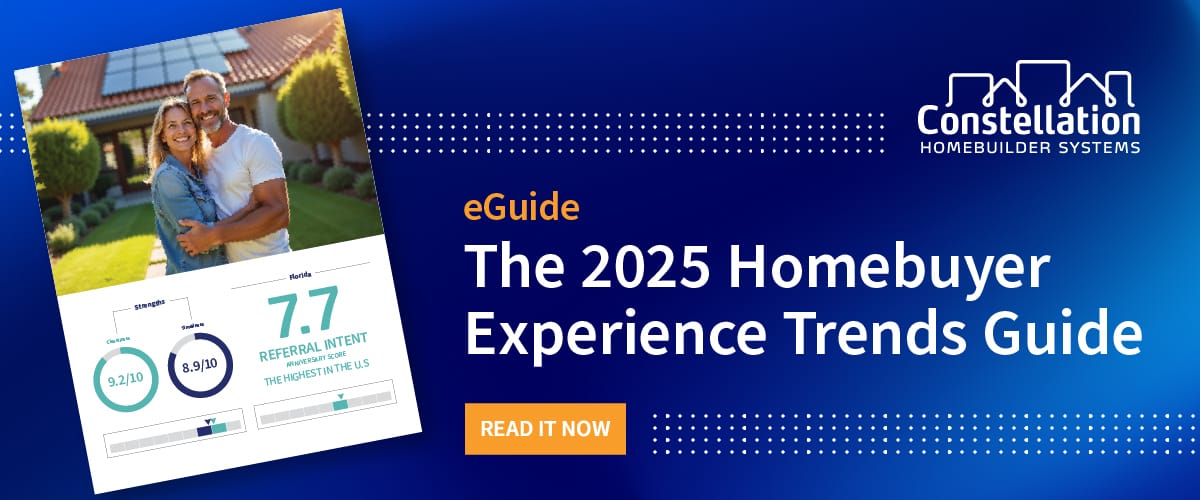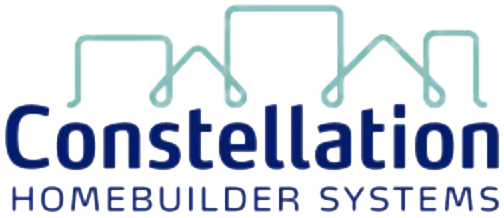Marketing & Sales
Why Customer Experience Will Impact Builder Outcomes in 2025
Referrals, repeat buyers, and reputation hinge on post-purchase care. Homebuilders who elevate CX will stand out in tough markets.

Why CX Matters Now More Than Ever
For U.S. homebuilders, 2025 has shaped up to be the most challenging sales environment in a decade. New single-family home sales fell 13.7% in May, dropping to a seasonally adjusted annual rate of 623,000 units — the lowest pace since October 2024, according to NAHB data. Inventory levels now sit at a 9.8-month supply, the highest in 10 years, despite builders increasingly resorting to incentives, with 37% reporting price cuts in June.
The affordability challenge is growing sharper. The median price of a new home reached $426,600 in May, up from $414,300 a year ago, with sales of homes under $500,000 down 15% year over year. Data from NAHB shows that the market for lower-priced homes (under $300,000) has collapsed by 65% since 2020, leaving first-time and middle-income buyers with fewer options.
Even when younger buyers do enter the market, they often rely on family money and support — with nearly one-quarter of Gen Z and millennial buyers using cash gifts or inheritance for their down payments, according to Redfin’s July 2025 survey. These intergenerational buying decisions make reputation and referrals from current and past customers more critical than ever.
This is where customer experience (CX) reveals its propulsive value as a growth engine.

Homebuilders facing sluggish traffic may be tempted to trim “soft” investments, such as customer care, but this is a strategic misstep. Today’s buyers can become either evangelists or detractors—especially when they see price cuts in the same neighborhoods where they have recently invested.
As Harvard Business Review points out, companies that chase new customers without nurturing existing ones often suffer backlash:
In the pursuit of growth, companies often strive to attract new kinds of customers. But if those new segments have needs, values, and preferences that differ from current buyers’, that approach can backfire spectacularly, driving away a firm’s loyal base and shrinking revenues.”
For homebuilders, extending “white-glove” post-purchase care for 12 to 24 months is not just about retention. It’s also about protecting the trust and advocacy of the people whose voices most influence the next wave of buyers.
In this environment, customer experience (CX) is no longer optional—it’s a lifeline. As the 2025 Homebuyer Experience Trends Guide from Constellation HomeBuilder Systems makes clear, the journey doesn’t end at closing. What happens in the 12 to 24 months after a buyer moves in can drive referrals, repeat purchases, and the kind of brand reputation that cuts through even the most stagnant markets.
The data shows that referrals and repeat buyers are critical catalysts when organic demand slows. Just as necessary, builders must manage relationships with recent buyers when new-home prices drop—because those customers can quickly turn from evangelists to detractors if they feel neglected. And in a crowded marketplace, builders who elevate post-purchase care will stand out.
This analysis highlights four reasons—and four imperatives—for making CX the cornerstone of homebuilding success in 2025.
Welcome Home Scores Are Up … 1-Year Satisfaction Is Down
While move-in satisfaction is improving, the real challenge begins after buyers settle in.
The home buying experience does not stop when the customer moves in,” says Donna Moore, Customer Experience Manager at Constellation HomeBuilder Systems. “The experience is a journey that covers the next 12 months, and it's how successful the builder can be in dealing with any warranty issues or deficiencies that will determine their referrals, or the potential for referrals going forward.”
Millennials and Gen Z buyers often rely on family experiences and referrals when selecting a builder. Winning a customer once is only part of the equation—earning their trust over time can generate repeat buyers within the same family network.
Actionable takeaway: Make post-purchase engagement a visible part of your brand promise by extending warranty support, creating homeowner education sessions, and encouraging families to share their positive experiences.
Process Drives Trust
High-performing builders have clear, consistent post-close processes that the entire team understands and follows.
Does the builder have a clear, concise process that everyone on their team understands to deal with every type of issue that may come up?" Moore says. "That's really what CustomerInsight is measuring. It's measuring process in the key areas that reflect customer satisfaction.”
Referrals Are the New Growth Engine
Referrals are one of the few demand catalysts that still work when traditional “Animal Spirits” buyer demand has slowed. Homebuyers who feel heard, respected, and supported—well beyond move-in—become the most effective brand advocates. In a slow market, referrals and repeat purchases are critical—and both hinge on CX.
The name of the game is high referrals,” Moore says. “A customer who is going to refer has had an excellent experience. That customer has cost that builder a lot less, because there are fewer callbacks – less time spent by the team dealing with issues. In turn, they offer a referral, which is important, especially in a competitive or down market.”
Surveys and check-ins at 30, 90, 180, and 360 days help builders stay ahead of issues before they become detractors.
Builders are free to choose when they do their surveys… Some do them at 90 days, or 180 days, followed by a 360-day survey,” says Moore. “It's up to the builder to decide what works best for their process."
Actionable takeaway: Implement structured 30-, 90-, and 365-day touchpoints using tools like Constellation’s CustomerInsight™ to ensure issues are resolved quickly — and to capture referral intent while satisfaction is high.
Accountability Scores Slip
Builders are communicating more often, but promises aren’t always being met. In neighborhoods where new homes are now being discounted compared to recent sales, builders risk turning satisfied buyers into detractors unless they invest in ongoing communication and care.
Accountability is really about measuring: Did the builder do what they said they were going to do and when they said they would do it? If there is no feedback from the builder to their homeowner in terms of how an issue is going to be dealt with, accountability scores will be low.”
Actionable takeaway: Position proactive CX as a hedge against frustration and resentment. Offering personalized check-ins, quick responses to issues, and service updates helps reinforce the value buyers received—regardless of changing market prices.
Regional Lessons
Data from Constellation’s 2025 Homebuyer Experience Trends Guide reveals that regional differences in builder practices can significantly impact long-term customer satisfaction. Texas-based builders excel in the early stages of the buyer journey, performing strongly on initial CX benchmarks such as sales communication and move-in quality. However, the data also shows a notable drop-off in post-close engagement, where early momentum is not sustained.
Texas builders are delivering houses as they should; they have the process down pat,” Moore observes. “However, later on, they are not keeping that trend up in terms of keeping that customer happy… communication is dropping off.”
Florida builders, by contrast, demonstrate a best-in-class model for maintaining proactive communication and responsiveness well after the keys are handed over. Their approach shows that CX must extend beyond the closing process and continue as a structured, intentional effort for 12 months or more.
It's continuing the same process that they had from sale to move in, and from move in to their one-year anniversary,” notes Moore. “They need to have the same clear process on communication, a way for that customer to easily report any issues, and have time to respond to that issue. Will the builder get back to the homeowner within a day or a week? It's about ensuring that the customer understands so their expectations are met throughout the process. The data is showing us in Florida that those expectations are being met throughout the process.”
This contrast between Texas and Florida highlights a broader insight: CX success is not just about what happens at move-in, but also about how consistently builders maintain trust, communication, and reliability in the months that follow.
Tackling the Biggest Challenge
As homebuilders strive to enhance their customer experience, one challenge often stands out: maintaining clear and responsive communication with homeowners after the sale. Service requests, surveys, and general follow-ups can quickly become complex without the right systems in place.
That’s where technology can make a difference. Platforms like Homeowner Central™ are designed to simplify these interactions, providing builders and homeowners a more streamlined way to stay connected.
It gives homebuyers a direct line into the builder’s process for handling service requests,” says Jeremy Halbert, Vice President of Customer Experience and Initiatives at Constellation HomeBuilder Systems. “That level of accessibility helps builders deliver better service, faster.”
When integrated with CustomerInsight, the portal also enables homeowners to access and respond to surveys directly, helping builders gather feedback and resolve issues more efficiently. Together, these tools support a more transparent, seamless post-purchase experience. As Halbert notes, builders who see the most significant benefits are those who weave these solutions into their daily operations with strong internal discipline and accountability.
Social Proof and Reviews
In a market where buyers rely heavily on online research, referrals, and reviews, satisfied customers are a homebuilder’s most powerful marketing asset. Positive word-of-mouth and strong social proof can help counteract market hesitancy—especially when buyers are weighing delayed purchase decisions due to concerns about price or interest rates.
Customers who are satisfied and happy with the builder cost a whole lot less than a customer who is experiencing a problem situation,” Moore asserts. “Those are the customers that are going to offer great reviews on social media. There is a clear gain on the bottom line for builders who are providing excellent customer service.”
The message is clear: delighting homeowners is not just good service—it’s an investment that pays for itself in lower service costs, stronger referrals, and better online reputation.
Recognition Reinforces Discipline
Constellation’s annual H.O.M.E. Awards are an added motivator for builders to achieve excellence in customer, trade, and employee satisfaction. In an oversupplied market, differentiation isn’t just about floor plans or incentives; it’s about how builders treat homeowners after the sale. In Japan, builders cultivate customer relationships for decades—an approach that creates lifelong loyalty and brand trust.
The H.O.M.E. Awards are based solely on the voice of the customer and are a big deal for builders. They love being able to celebrate and promote their successes," Halbert says. "It helps encourage them throughout the year to focus on their level of excellence continually.”
Actionable takeaway: Use CX as a strategic differentiator.
CX is not a buzzword or a soft metric.
It’s a direct lever for sales performance and profitability, especially when new home demand is muted. It’s also a reflection of how profoundly consumer expectations have changed—and how much influence a single buyer’s experience now has on the decisions of future buyers. Builders who invest in “white-glove” care for 12 to 24 months post-move-in will not only weather this challenging market but also stand out – and win new sales – as leaders in trust and customer advocacy.
Constellation provides fully-integrated or standalone software solutions expertly engineered to manage the complete ecosystem of a homebuilder’s business functions and growth.
MORE IN Marketing & Sales
How Homebuilding Sales Became A Strategic Center Of Gravity
Dave Rice and New Home Star help turn homebuilder sales associates into data-powered business strategists and a linchpin to critical customer feedback. Here’s why that matters now more than ever.
U.S. Apartment Rents Post First Third-Quarter Drop Since 2009
Apartment rents slipped for the first time since the Great Recession, signaling a cooling market driven by oversupply. Developers are pulling back—but economists warn the pause won’t last. Richard Lawson explores how and why.
Why Homebuilders Must Widen Their Lens On Today’s Buyers
Families with kids matter. However, they’re no longer the entire market. Singles, empty nesters, and multigenerational households are reshaping who buys new homes. Barbara Wray shows builders how to reflect today’s real buyer mix.


